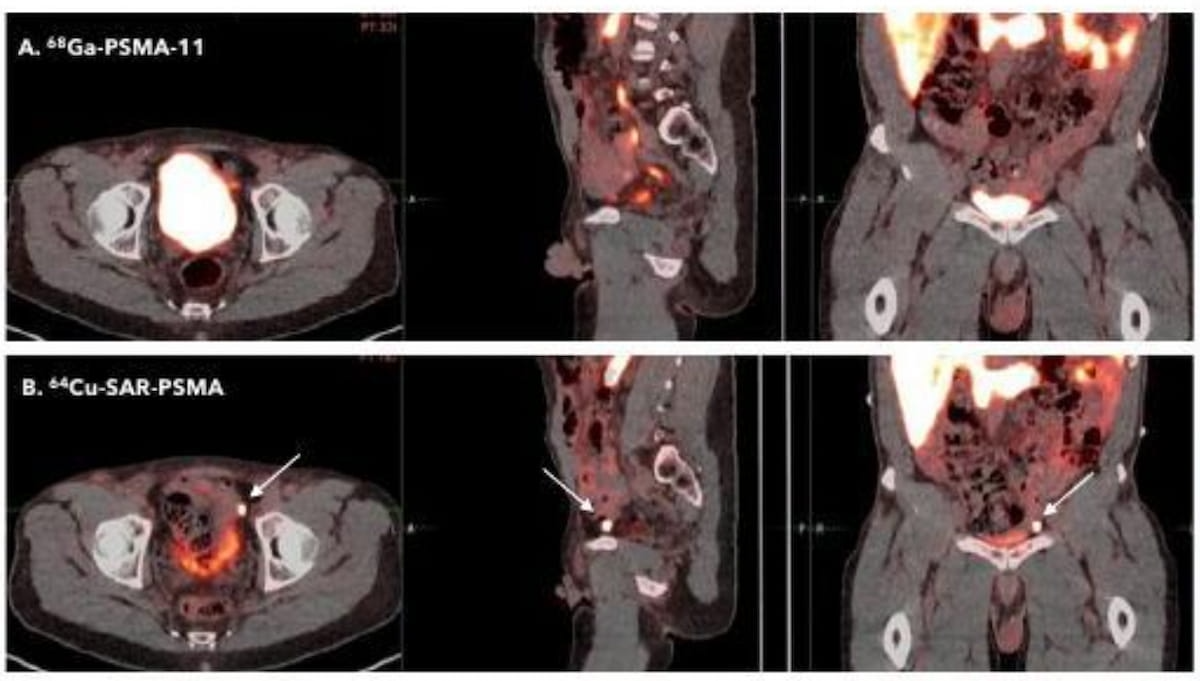Emerging PSMA PET Agent May Offer Improved Detection of Prostate Cancer
The PSMA PET agent 64Cu SAR-bisPSMA detected a higher number of prostate cancer lesions and had a significantly higher SUVmax and SUVmean than 68Ga PSMA-11 PET/CT, according to initial data from a prospective multisite study presented at the recent Society of Nuclear Medicine and Molecular Imaging (SNMMI) conference.
Could there be a new standard of care for prostate-specific membrane antigen (PSMA) positron emission tomography (PET) detection of prostate cancer?
In a study that was presented at the recent Society of Nuclear Medicine and Molecular Imaging (SNMMI) conference, researchers compared initial PSMA PET imaging with 68Ga PSMA-11 PET/CT to different dosing regimens of the PSMA PET agent 64Cu SAR-bisPSMA in 30 men with intermediate to high-risk prostate cancer. The study authors noted the dosing cohorts for 64Cu SAR-bisPSMA were 100 MBq, 150 MBq and 200 MBq. All PSMA PET scans were assessed by two blinded readers, according to the study.
The first reader diagnosed 63 prostate cancer lesions with 64Cu SAR-bisPSMA versus 51 lesions with 68Ga PSMA-11 PET/CT across all cohorts, and the second reader detected 34 lesions with 64Cu SAR-bisPSMA in comparison to 25 lesions with 68Ga PSMA-11 PET/CT, according to the phase 1, prospective, multisite study.
The researchers found that use of 64Cu SAR-bisPSMA resulted in a higher median SUVmax for the readers (30.3 and 41.7) in contrast to 68Ga PSMA-11 PET/CT (13.5 and 14.9). The study authors also noted that 64Cu SAR-bisPSMA had a significantly higher SUVmean (21.2 vs. 9.1 for the first reader and 28.4 vs. 9.94 for the second reader) and higher median tumor-to-background (TBR) ratios (53.6 vs. 24.3 for the first reader and 78.4 vs. 24.7 for the second reader) in comparison to 68Ga PSMA-11 PET/CT.
Noting that 64Cu SAR-bisPSMA may offer “improved tumor uptake and retention compared to PSMA monomers,” researchers found that the PSMA PET agent had significantly higher SUVmax and SUVmean in comparison to 68Ga PSMA-11 in a recent study. (Images courtesy of the Society for Nuclear Medicine and Molecular Imaging.)

“More lesions were detected, and lesions exhibited higher SUVmax, SUVmean and TBR by 64Cu SAR-bisPSMA compared to 68Ga PSMA-11 in men being staged with intermediate- and high-risk (prostate cancer),” wrote study co-author Louise Emmett, M.D., the director of the Department of Theranostics and Nuclear Medicine at St. Vincent’s Hospital in Sydney, Australia, and colleagues.
(Editor’s note: For related content, see “Is Pre-Imaging Biopsy Necessary for Prostate Cancer Staging in Elderly Patients?,” “Utilizing AI for Quantitative Assessment of Prostate Cancer Recurrence” and “Emerging PET Radiotracer May Offer Multiple Advantages in Detecting Prostate Cancer.”)
In contrast to other PSMA agents that have a single targeting functional group, the study authors said a key advantage of 64Cu SAR-bisPSMA is two PSMA-targeting functional groups.
“This can lead to improved tumor uptake and retention compared to PSMA monomers, which may be highly relevant in patients with suspected disease or suspected recurrence where the detection of lesions may lead to a change in management,” noted Emmett and colleagues.
(Editor’s note: For additional content and video interviews from the SNMMI 2023 conference, visit https://www.diagnosticimaging.com/conferences/snmmi .)
Clarity Pharmaceuticals, the developer of 64Cu SAR-bisPSMA, is reportedly planning to initiate a prospective phase 3 study of the agent later in 2023.
Reference
1. Lengyelova E, Wong V, Lenzo N, Parker M, Emmett L. Comparison of PET/CT in subjects with confirmed prostate cancer using 64Cu SAR-bisPSMA and 68Ga PSMA-11. Poster presented at the Society of Nuclear Medicine and Molecular Imaging (SNMMI) 2023 Annual Meeting, June 24-27, 2023, Chicago. https://am.snmmi.org/iMIS/SNMMI-AM?utm_source=dropdown&utm_medium=website&utm_id=AM2022&navItemNumber=581
Newsletter
Stay at the forefront of radiology with the Diagnostic Imaging newsletter, delivering the latest news, clinical insights, and imaging advancements for today’s radiologists.
SNMMI: Botox May Facilitate Relief from Dry Mouth Side Effect of PSMA-Targeted Radiopharmaceuticals
June 25th 2025For patients being treated with radiopharmaceutical agents for metastatic prostate cancer, the combination of botulinum toxin and an anti-nausea patch led to a 30 percent reduction in PSMA uptake in the salivary glands, according to preliminary research findings presented at the SNMMI conference.
SNMMI: Can 18F-Fluciclovine PET/CT Bolster Detection of PCa Recurrence in the Prostate Bed?
June 24th 2025In an ongoing prospective study of patients with biochemical recurrence of PCa and an initial negative PSMA PET/CT, preliminary findings revealed positive 18F-fluciclovine PET/CT scans in over 54 percent of the cohort, according to a recent poster presentation at the SNMMI conference.
Could an Emerging PET Tracer be a Game Changer for Detecting Hepatocellular Carcinoma?
June 23rd 2025In addition to over 90 percent sensitivity in detecting hepatocellular carcinoma (HCC), the glypican-3 (GPC3) targeted PET tracer 68Ga-aGPC3-scFv appeared to be advantageous in identifying HCC tumors smaller than one centimeter, according to pilot study findings presented at the SNMMI conference.
SNMMI: What a New Meta-Analysis Reveals About Radiotracers for PET/CT Detection of PCa
June 22nd 2025While (68Ga)Ga-PSMA-11 offers a pooled sensitivity rate of 92 percent for prostate cancer, (18F)-based radiotracers may offer enhanced lesion detection as well as improved imaging flexibility, according to a meta-analysis presented at the Society for Nuclear Medicine and Molecular Imaging (SNMMI) conference.
SNMMI: Can Multimodal Monitoring Bolster Outcomes with Pluvicto in Treating mCRPC?
June 22nd 2025Multimodal treatment monitoring, including SPECT/CT exams 24 hours after treatment with Lu-177 PSMA-617, may have facilitated significantly shorter therapy durations and reduced side effects in patients with mCRPC, according to a two-year study presented at the Society for Nuclear Medicine and Molecular Imaging (SNMMI) conference.